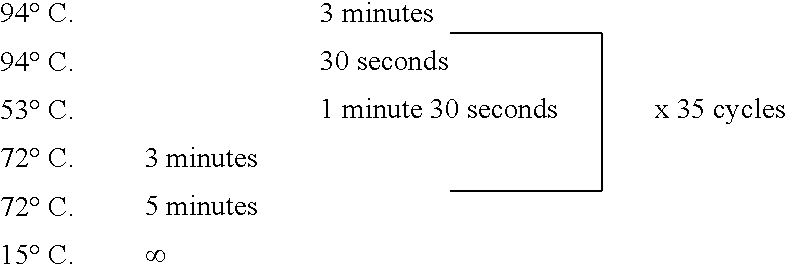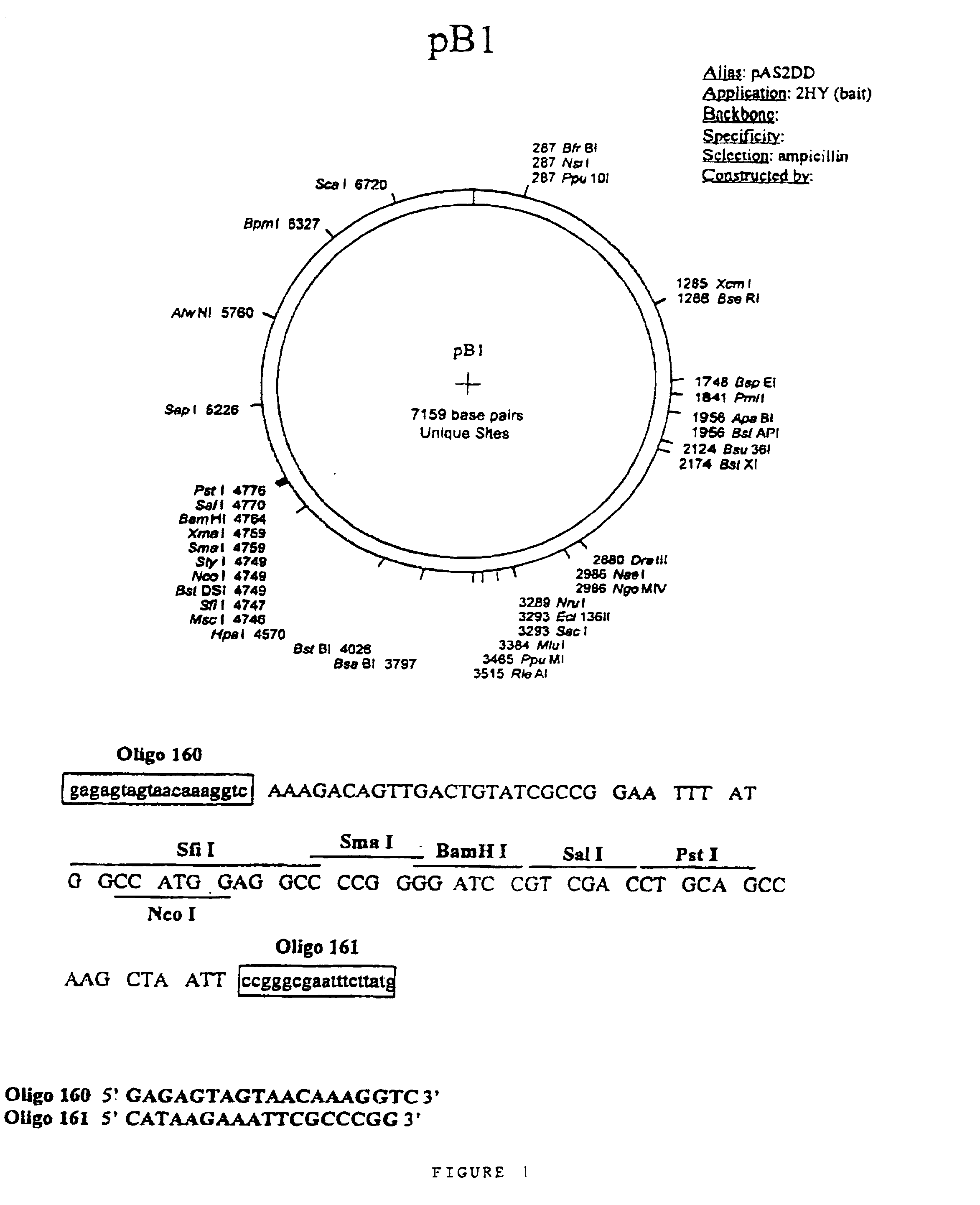Protein-protein interactions between Shigella flexneri polypeptides and mammalian polypeptides
- Summary
- Abstract
- Description
- Claims
- Application Information
AI Technical Summary
Benefits of technology
Problems solved by technology
Method used
Image
Examples
example 1
Preparation of a Collection of Random-primed cDNA Fragments
[0193] 1.A. Collection Preparation and Transformation in Escherichia coli
[0194] 1.A.1. Random-primed cDNA Fragment Preparation
[0195] For the human placenta mRNA sample, random-primed cDNA was prepared from 5 .mu.g of polyA+ mRNA using a TimeSaver cDNA Synthesis Kit (Amersham Pharmacia Biotech) and with 5 .mu.g of random N9-mers according to the manufacturer's instructions. Following phenolic extraction, the cDNA was precipitated and resuspended in water. The resuspended cDNA was phosphorylated by incubating in the presence of T4 DNA Kinase (Biolabs) and ATP for 30 minutes at 37.degree. C. The resulting phosphorylated cDNA was then purified over a separation column (Chromaspin TE 400, Clontech), according to the manufacturer's protocol.
[0196] 1.A.2. Ligation of Linkers to Blunt-ended cDNA
[0197] Oligonucleotide HGX931 (5' end phosphorylated) 1 .mu.g / .mu.l and HGX932 1 .mu.g / .mu.l.
[0198] Sequence of the oligo HGX931: 5'-GGGCCAC...
example 2
Screening the Collection with the Two-hybrid in Yeast System
[0224] 2.A. The Mating Protocol
[0225] The mating two-hybrid in yeast system (as described by Legrain et al., Nature Genetics, vol.16, 277-282 (1997), Toward a functional analysis of the yeast genome through exhaustive two-hybrid screens) was used for its advantages but one could also screen the cDNA collection in classical two-hybrid system as described in Fields et al. or in a yeast reverse two-hybrid system.
[0226] The mating procedure allows a direct selection on selective plates because the two fusion proteins are already produced in the parental cells. No replica plating is required.
[0227] This protocol was written for the use of the library transformed into the Y187 strain.
[0228] For bait proteins fused to the DNA-binding domain of GAL4, bait-encoding plasmids were first transformed into S. cerevisiae (CG1945 strain (MATa Gal4-542 Gal180-538 ade2-101 his3.DELTA.200, leu2-3,112, trp1-901, ura3-52, lys2-801, URA3::GAL4 1...
example 3
Identification of Positive Clones
[0278] 3.A. PCR on Yeast Colonies
[0279] Introduction
[0280] PCR amplification of fragments of plasmid DNA directly on yeast colonies is a quick and efficient procedure to identify sequences cloned into this plasmid. It is directly derived from
[0281] a published protocol (Wang H. et al., Analytical Biochemistry, 237, 145-146, (1996)). However, it is not a standardized protocol and it varies from strain to strain and it is dependent of experimental conditions (number of cells, Taq polymerase source, etc). This protocol should be optimized to specific local conditions.
[0282] Materials
[0283] For 1 well, PCR mix composition was:
[0284] 32.5 .mu.l water,
[0285] 5 .mu.l 10.times.PCR buffer (Pharmacia),
[0286] 1 .mu.l dNTP 10 mM,
[0287] 0.5 .mu.l Taq polymerase (5u / .mu.l) (Pharmacia),
[0288] 0.5 .mu.l oligonucleotide ABS1 10 pmole / .mu.l: 5'-GCGTTTGGAATCACTACAGG-3',(SEQ ID NO. 424)
[0289] 0.5 .mu.l oligonucleotide ABS2 10 pmole / .mu.l: 5'-CACGATGCACGTTGAAGTG-3'.(SEQ ...
PUM
| Property | Measurement | Unit |
|---|---|---|
| Composition | aaaaa | aaaaa |
| Interaction | aaaaa | aaaaa |
Abstract
Description
Claims
Application Information
 Login to View More
Login to View More - R&D
- Intellectual Property
- Life Sciences
- Materials
- Tech Scout
- Unparalleled Data Quality
- Higher Quality Content
- 60% Fewer Hallucinations
Browse by: Latest US Patents, China's latest patents, Technical Efficacy Thesaurus, Application Domain, Technology Topic, Popular Technical Reports.
© 2025 PatSnap. All rights reserved.Legal|Privacy policy|Modern Slavery Act Transparency Statement|Sitemap|About US| Contact US: help@patsnap.com



